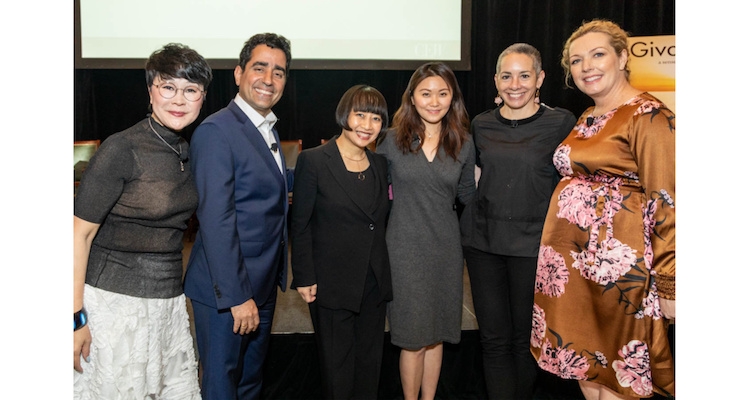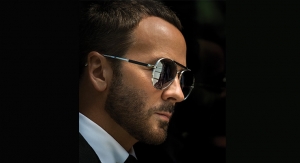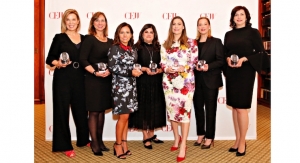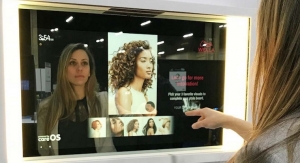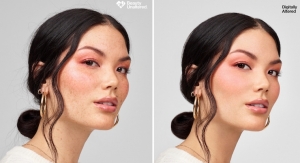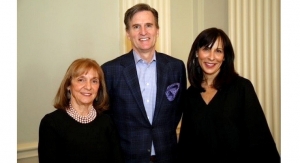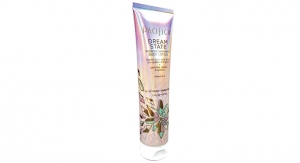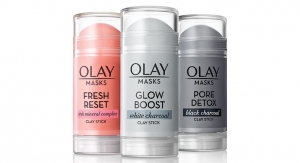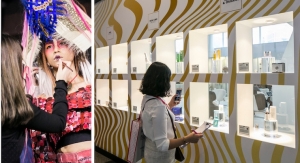Nancy Jeffries05.02.19
On April 24, 2019, Cosmetic Executive Women (CEW) presented a Speaker Series event titled, “How to Win in China’s Beauty Market,” featuring leaders in the industry.
Jill Scalamandre, chairwoman, CEW, and president, Shiseido Global Makeup Center, introduced the panel's presenters:
- Lan Vu, founder/CEO, BeautyStreams
- Freddy Bharucha, vice president America & Global Personal Care, P&G Beauty
- Jackie Lee, category lead – Beauty, Cosmetics & Fragrances, Alibaba Group/Tmall Global
- Kristy Watson, chief marketing officer, Erno Laszlo
- Wei Brian, founder & CEO, Wei Beauty
- Jenny Fine, moderator, and executive editor, Beauty Inc, WWD
- Arnaud Guggenbuhl, global marketing head, Fine Fragrance, Givaudan
In her introduction, Scalamandre cited a recent Euromonitor report, noting that the Chinese beauty market is experiencing rapid growth, with sales in beauty and personal care projected to grow to $62 billion by 2020. She thanked sponsors, Givaudan, 24/Seven, Beauty Inc, Wei Beauty, RéVive, Moblty, WWD, Fabler, and Kaplow Communications, and introduced Arnaud Guggenbuhl, Givaudan, to present an overview of fragrance in the Chinese Market.
Intel and Data
Guggenbuhl’s observations about the Chinese market painted a picture of an extremely discerning consumer. “The Chinese consumer wants to be seen as a scent connoisseur. The Chinese market is about gifting for others, as well as gifting to oneself,” said Guggenbuhl. He described a demographic with wide-ranging tastes and preferences, noting, “The olfactive spectrum runs from juicy and fruity to fine, sophisticated elegance.”
In her data and intel presentation, Lan Vu, BeautyStreams, elaborated on the background, market trends, and influencers in the Chinese market, describing the rapid changes that are occurring within the market, as well as the perceptions of the market itself. Regarding manufacturing, she said, “The concept of quick goods and bad quality has changed, and the Next Gen demographic is fueling growth.” The Cultural Revolution has wiped away the past, explained Vu, and today’s young generation in China is embracing their heritage with a fresh perspective.
Smart development is front and center, with the mobile market in China being the largest in the world. Smart development is led by Millennials and Gen Z, and advances in technology, like Artificial Intelligence (AI) and virtual reality are changing the buyer experience.
Lan Vu also noted that the Green Movement was strong in China, and well-informed beauty consumers expect quality and are willing to pay for it. She cited the “Made in China 2025” program, which encourages local industries to focus on making higher quality goods.
The Post-90’s demographic in China is drawn to heritage beauty brands, instant gratification, and seeks self-expression through beauty. They are avid followers of KOL’s (Key Opinion Leaders), and they are critical of products. The 35+ Generation values health and is interested in natural and traditional Chinese medicine; while the men’s market, driven by newly sophisticated consumers of beauty products, face masks, skincare and eye and brow liners, as well as K-pop-inspired KOL’s, comprise a growing demographic.
New brands, like Marie Dalgar, reflect strong Chinese positioning linking beauty to art. Others include Color Studio, Yes! IC, and So Cool So Me. Vu cited Scent Library as a Beijing fragrance brand created by young husband and wife designers that is inspired by global cities and settings. “It captures a new way of thinking,” said Vu. In addition, she noted the impact of “influencers” in China, including Zhang Mofan Momo, with more than 12 million followers, who does beauty tutorials and is a commercial success with her popular brand, Mo Amour, which offers customized aromatherapy skincare; and Junping Big Devil, with 8.03 million followers. This male beauty blogger has his own brand called Junping, in China, and reflects a professional, scientific, ironic, and critical positioning. China’s top local brand, Pechoin, is a skincare brand, founded in 1931, and once considered stately. It has now, through re-branding and KOL marketing campaigns, been transformed to appeal to today’s youth, and is now China’s top local skincare brand.
Panelists Reflect on the Market
Remaining relevant and present with consumers in the Asian market is the greatest challenge that brands are facing today. Freddy Bharucha, P&G, addressed the transformation in China, saying, “It has been a mixed bag. The market has seen a lot of growth. Key to the turnaround was almost ‘unlearning’ the traditional ways of doing business. We chose to cut reach by 30% and still we grew quite dramatically.”
Skincare is a strong category for Asian consumers over 35 and China has been a key strategy behind P&G’s positioning of Olay as a global leader in the category. Olay’s China business has grown double digits for seven consecutive quarters, in what is considered one of the world’s most contested skin care markets.
Bharucha provided insight into this market with his characterization of the Chinese consumer. “First, the consumer in China expects quality at a high level. The details and specificity of ingredients the consumer wants are even higher than the consumer in Japan,” he said. “Second, design and packaging have gone to another level. We have to upgrade our packaging to create holistic design and a prestige experience,” he said, citing Olay’s packaging.
“Luxury is not just about packaging. It’s the experience the consumer is having both online and off at the counter. Consumers expect very high quality and we have 5,000 beauty consultants to provide a holistic experience that is crucial,” he said. Bharucha acknowledged that digital, social, and e-commerce are important ways to transmit key content to consumers. “The most important is connecting with the consumer on the proposition of the brand,” he said, noting the “Living Your Life Fearless” campaign, that was a big success for Olay.
Kristy Watson, Erno Laszlo, reflected on the importance of having strong social media and e-commerce, both key to market penetration. Of China’s 802 million Internet users, 788 million access the web via mobile devices, such as smart phones, according to the China Internet Network Information Center. As a result, the country generates the biggest mobile app sales in the world. Understanding the social platforms and apps for beauty brands launching in the Chinese market is critical to a brand’s success. Watson said, “In the U.S., our consumers check out our rave reviews on Sephora and Amazon, and in China they rely on their WeChat groups or Little Red Book.”
While Watson noted that Erno Laszlo had an older consumer, the brand was able to tell its story with digital to a younger consumer. “We have an office in Shanghai, and we lead with digital. The Laszlo brand is a 93-year-old brand that is all about one-to-one action, so we have been able to marry our brand essence with efficacy. The Chinese market goes crazy for our story, which has had the iconic representation of both Marilyn Monroe and Audrey Hepburn,” she said.
Watson described her first trip to China, during which she found great enthusiasm for the brand. As part of the process, however, she said, “There are no concrete rules and we’re trying to understand how to reach the consumer in conjunction with our Chinese team. We’ve found that brands kind of take on a life of their own and we’re lucky the Chinese consumer sees the value of it. It’s super invigorating and I’m happy to be part of it.”
The founder of Wei Beauty, Wei Brian, shared her brand’s proposition, saying that while the brand launched in the U.S. and London first, and then went to China, it incorporated an emphasis on traditional medicine, as well as luxury. Chinese consumers are open to spending additional dollars on beauty products to benefit from better quality and innovation, and according to Brian, utilizing these principles, in a luxury brand, has answered the demand for the seriousness with which Chinese girls take skin care.
In sharing her insights into the prestige beauty market, Brian said, “They are tough customers to satisfy. Everything has to be beautiful and meet their expectations. If you’re able to give them that, they will really embrace you.” Brian added, “They think their skin is like tofu, and they are really serious about taking care of it.” Brian decided to move back to China after originally leaving in 1985 and coming the United States. She now describes doing business in China as exciting and rapidly changing. “Shanghai is like Paris and Manhattan together,” she said, adding, “The changes happen so fast that if you only go every six months there are already so many changes.”
Jackie Lee discussed the Alibaba eco-system, including Alibaba Tmall, which she said was leading the way for overseas brands and retailers to reach consumers. Chinese consumers enjoy browsing on Tmall, but also shop at malls and stores, where they expect to be entertained. Alibaba’s Tmall Global recently announced initiatives aimed at helping brands and retailers of all sizes manage their entry into China to reach and engage with consumers. Seven international cosmetic companies, including Tom Ford Beauty; Glamglow; P&G’s new beauty line, Oriental Therapy; Japan’s Cosme and d-program; Primera from Korea; and Barnängen, from Sweden, have signed agreements to open flagship stores on Tmall in 2019.
Lee described how Alibaba and Tmall can not only be a sales channel, but also a branding powerhouse for brands and retailers to shape their strategies for the China market. “If you think of Amazon and influencers and pop-up banners, these are part of the Alibaba eco-system. We have reached 100 million every day with our logistics in order to provide the best consumer insights,” she said. Bharucha commented, “From a brand point of view, Alibaba understands brands like no other. You cannot run a China business sitting in a different part of the world. You’ve got to be there, live there, and have your organization there. It’s an incredibly fluid eco-system, which includes Visa, Mastercard and more; all part of this eco-system. You’ve got to engage the consumer with a digital footprint.”
“In my mind, Alibaba is a country and the people who engage in it are citizens of that country,” said Bharucha. Lee said that Alibaba serves over 50% of Chinese consumers. “Throughout the entire eco-system, the brands are represented and the consumers can engage with the KOL’s,” she noted. Brian acknowledged that there are different platforms, and that if you want to build a digital footprint, you have to partner with a platform of social and digital. “You ultimately want to do it all, and P&G has probably done that,” said Brian.
Watson said the Key Opinion Leaders that she worked with in Canada were of Chinese descent and they worked cross-border with Instagram. “I would be balanced,” said Bharucha. “All the US names, like We Chat and Instagram are good, but the Chinese equivalents are the primary force, not the Facebooks,” added Bharucha. Watson highlighted the Little Red Book as a community where you can share with your friends what you’ve bought, for example, in beauty and skin care. She said, “When girls want to find something interesting they research the Little Red Book. Last year we made an investment there and included them in our Alibaba system, and now consumers can reference both.”
On the subject of animal testing, panelists agreed that taking a stand is the only way to change legislation. Bharucha said, “We play by the rules and are very transparent. We don’t circumvent the system, we work with it.” Watson added, “Erno Laszlo takes the stand that you have to be in the process to change things. We do not do animal testing and we believe it is changing. It will continue to change and the floodgates will open.” Bharucha noted that he was a vegetarian, and wanted to continue to work to change the testing regulations.
Lan Vu joined the panel to address the best ways to operate in China, saying, “It is most important to be agile and meet consumer demands.” Bharucha said, “We had to reorganize to solve the consumer demand, and decentralizing was a crucial part of that.” Vu acknowledged the numerous Key Opinion Leaders in both China and the US, saying that their power is a phenomenon; while Brian referred to the plethora of young boy stars in China, known as “fresh meat,” who are trend influencers; with Lee acknowledging that the fresh meat cadre represents influential opinions on color, makeup, fashion. She also emphasized the different roles that mobile apps play in marketing in the East and the West.
Bharucha said that while the fundamentals may be the same, the difference is in the consumer. Sixty-six percent of Chinese consumers look for recommendations on social platforms; while 33 % of US consumers look for recommendations on social platforms. Lee cited a telling statistic, adding, “In China, mobile penetration is over 95% already.” Clearly, an important insight for those contemplating business in the market.

